Despite putting themselves in a desperate financial situation with years of mismanagement, Barcelona are back in the market. While the main priorities remain higher up the pitch, it’s becoming painfully obvious the defensive line will need reinforcement as well; specifically, the full-back areas.
However, the market for full-backs is scarce, to say the least. The top picks are either not for sale or would cost far too much to acquire, especially given the majority of Barcelona’s budget won’t be spent on them. But that doesn’t mean there aren’t any options. Sometimes, it takes a little risk to unearth the next gem, just like Liverpool did with Trent Alexander-Arnold or the way Manchester City moulded João Cancelo into a world-class player. None of that was crystal clear at first.
So in this data analysis, we’ll scout different leagues for a potential right-back and a left-back for Barcelona to acquire in the near future. We’ll use statistics and data to showcase their profiles and then further analysis via the eye test to determine their suitability.
But first, we need to define the sample.
The sample
For the purpose of this analysis, I’ve used full-backs from the following leagues: The top-five leagues, the Championship and the first divisions from Argentina, Brazil, Portugal, Japan and the Netherlands. The players were filtered with an age limit of 28 as we want either young players or ones in their prime years and only the ones who have played at least 700 minutes in the 2021/22 campaign.
Even though some wingbacks were included in the analysis, the sample is still pretty strict so players who are primarily centre-backs but also play in the wide roles, such as Joško Gvardiol or Jules Koundé, didn’t make the cut. Similarly, pure wingers who are sometimes deployed deeper were also excluded.
Finally, the metrics used were differently prioritised for the two roles because Barcelona use their full-backs differently depending on the side on which they operate. More on that later.
The left-back role
Before we dive into the numbers, it’s important to understand what kind of player we’re looking for here. The left-back role has largely been defined by Jordi Alba in Barcelona’s modern iteration and given the profiles they have at the club, it’s likely that mould of a player will persist even after the Spaniard’s departure or retirement.
If we assume Ansu Fati remains fit, there is little doubt he’ll be the one to start at Barcelona’s left flank as an inverted winger or an inside forward. The alternative so far has been Xavi using Gavi in a false winger role, tucking inside and overloading the midfield rather than stretching the pitch. That would be Alba’s role.
He’s tasked with attacking space, acting as an offensive full-back-cum-winger with a great influence in the final third but limited involvement everywhere else. Compared to other full-backs in the league, Alba still registers more touches than most but that’s because Barcelona are such a possession-heavy team. He’s very involved but his role isn’t complex; he’s recycling possession when necessary and tucks in to create overloads when asked but generally, Alba’s main focus is in the final third of the pitch. As such, we’ll be looking for a left-back who can replicate his attacking output while still fitting the system in general.
However, considering we can’t 100% predict that is indeed the profile the club will need, this data analysis will provide different options depending on the situation in other positions. If the width and penetration are provided by the winger — be that by Fati or someone else — the full-back will have a more supportive/creative role. As such, it will require a different profile. With that said, however, it is largely reported Barcelona want Erling Haaland to play alongside Ferran Torres and Fati for the foreseeable future. While certainly stacked with incredible attacking potential, that frontline doesn’t have a clear creator and could struggle because of it.
For that reason, and despite a great midfield, they will need their full-backs to carry the major brunt of creativity, either through their 1v1 prowess or elite delivery into the danger area. I’ve narrowed down the metrics to four main categories so they reflect that need. You can see the first two in the graph below. These will primarily help us identify highly creative wide players who are strong in attacking duels and on the ball.
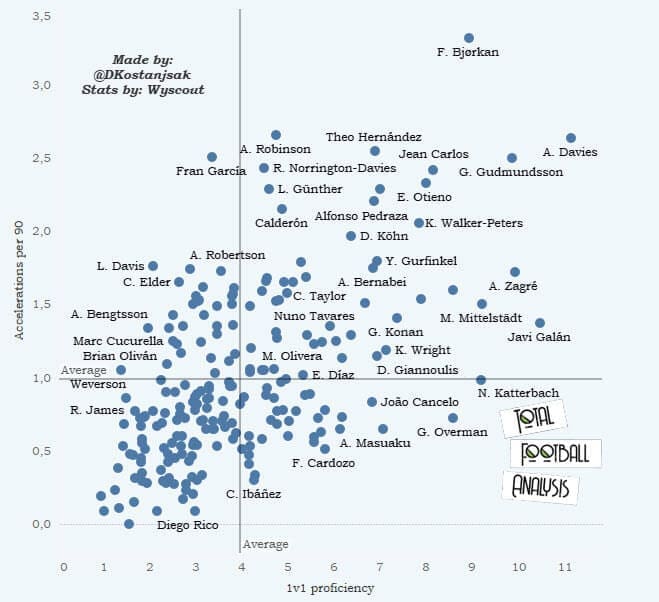
No data can reliably tell us how often a player attacks space but I’ve used accelerations per 90, which show us progressive carries over a large distance with a significant increase in speed, against 1v1 proficiency, a metric of my own making. To test a player’s 1v1 proficiency, I’ve calculated their successful offensive duels per 90, their successful dribbles per 90 and added them together.
It’s a pretty simple metric but it shows us how successful the players are in direct duels or when trying to beat their man in possession. If they’re accelerating often and are great in 1v1 challenges, it’s fair to also assume they would have no problem being isolated out wide and charging into the final third. The results confirm the thesis as our sample of players fit the profile.
Alphonso Davies is the obvious standout star; proficient in both but also quite well known and frankly, mostly unattainable. The 23-year-old Fredrik André Bjørkan, however, is very interesting. The young left-back is quite pacey with and without the ball and is very efficient when beating his man — definitely one to keep an eye on as we move forward. Other notable players include Jean Carlos, Gabriel Gudmundsson, Theo Hernández and Eric Ouma Otieno, all of whom have recorded impressive results in both categories.
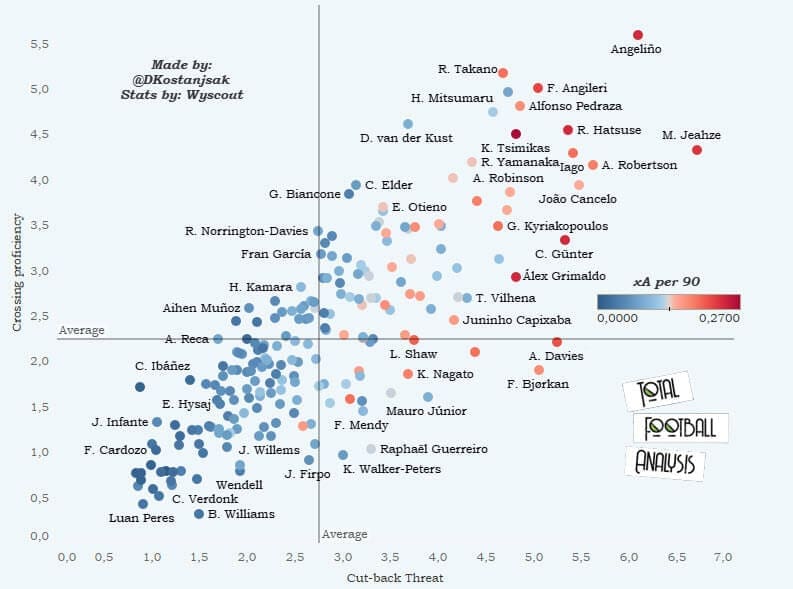
The second graph deals with the other key attribute a Barcelona left-back must have — lethality in the final third. Alba isn’t a player who scores a lot of goals but he will create them and pose threat on the ball. To get a good sense of that threat, I’ve decided to look at crossing proficiency and cut-back threat, both of which are, again, self-made metrics.
Crossing proficiency consists of accurate crosses per 90, deep completed crosses per 90 and crosses to goalie box per 90, giving us a good scope of all major crossing categories available via Wyscout. Cut-back threat is a combination of xA per 90, deep completions per 90, deep completed crosses per 90, key passes per 90 and shot assists per 90. Given how the xA per 90 has by far the lowest values, it’s easy for it to get lost within the other ones so I’ve also shown it through the colour of the dots above.
The clear standout here is RB Leipzig’s Angeliño whose ability on the ball and especially in the final third is ridiculously good. Some other names that excel in these categories are the likes of Ryo Takano, Fabrizio Angileri, Alfonso Pedraza and Ryo Hatsuse. Of course, Andrew Robertson and Cancelo are also here, which isn’t a big surprise.
But Davies and Bjørkan are outliers in only one category, which is the cut-back threat. Despite not being elite crossers of the ball, this metric is still enough for them to impress. Combined with their clear domination of the previous two categories, the cut-back threat alone is a good indicator of their suitability.
To ensure our sample isn’t too limited and mostly dominated by high-flying options akin to Alba, I’ve decided to take a look at players who are more combinatory by nature, something that is nowadays more related to Barcelona’s right-backs.
To do that, I’ll look at their link-up and progression potential as well as their ability to unlock deep defensive blocks through smart passing and lethal balls into danger areas. We’ll start the analysis by looking at smart passes per 90 and passing threat, another metric I made for this article. It is a combination of accurate through passes per 90, deep completions per 90, key passes per 90 and crossing proficiency. This gives us players who are proficient at creating while also linking up with their teammates deep in the opposition’s block.
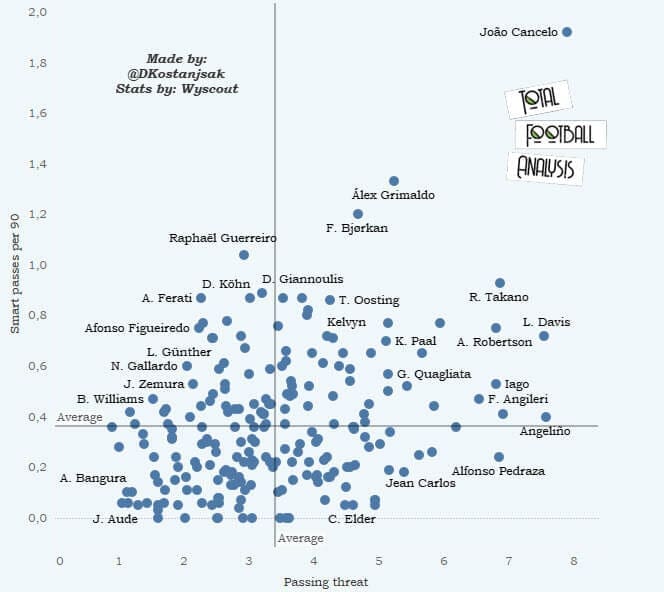
Cancelo is the absolute winner in these two categories, topping the charts by some distance. But considering he’s not a realistic option, we’ll disregard him for now. It’s very nice to see Álex Grimaldo ranking very highly here because he was also present in some of the previous metrics and is a very realistic target for Barcelona. But again, Bjørkan is the one impressing here with very good numbers in both categories.
And even though he’s much of a ‘smart passer’, Pedraza is lethal in his passing overall, which can be seen in him dominating the passing threat category. Again, good signs since he was one of the standout players in the first two graphs. The same can be said for Fulham’s Antonee Robinson, who’s really starting to pop up now that we’re expanding the metrics. This can also be seen in the following graph.
Kostanjsak Domagoj 4
Progressive actions here represent a combination of progressive runs and carries per 90 while passes to the danger area are combinations of passes to the final third and the box per 90. Cancelo, Robinson and even Bjørkan are present again, which we have to make note of. But this time, we also have some new names topping the charts, such as Jean-Kévin Duverne or Raphaël Guerreiro, both of whom look like interesting options in their own right.
Now that we’ve analysed the main metrics, it’s time to see who are the players that could make our shortlist.
The left-back shortlist
1. The high-flyer option: Alfonso Pedraza
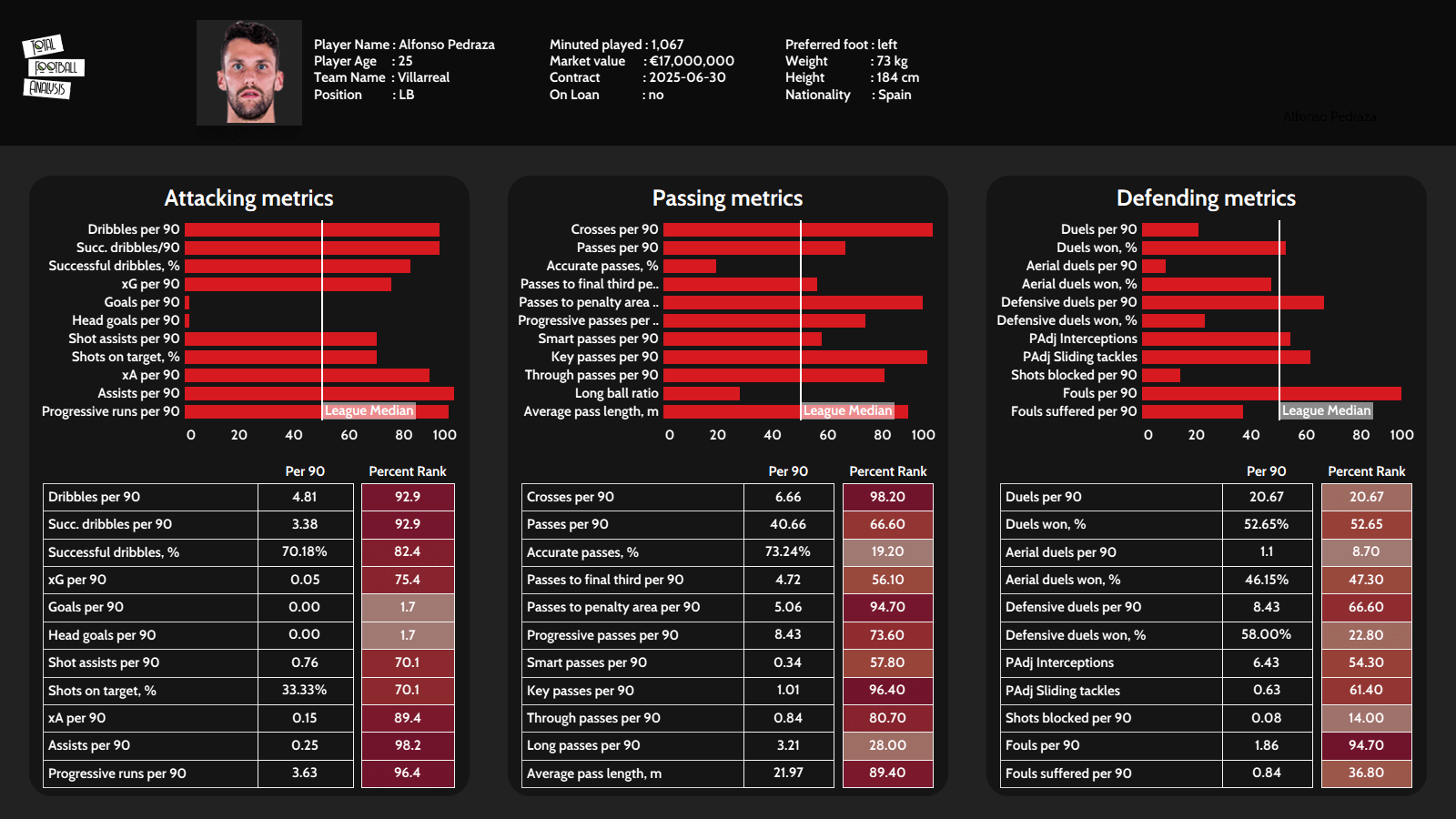
It’s tough to justify the inclusion of a player that is not a regular starter at his own club, let alone stating he should potentially replace someone as influential as Alba. I don’t see Pedraza as Barcelona’s next big thing because he likely wouldn’t be that but if they are looking for someone who can mirror what Alba does in a specific system, he is a very good choice. Pedraza is in his prime years and likely won’t get much better unless Barcelona somehow allow him to break through his ceiling.
This is a real possibility in a team that can theoretically give him better conditions than Villarreal within the exact same LaLiga environment. Pedraza knows the league, knows the opposition and we also know he can perform at a high level. Granted, it may not be an easy transition. We’ve already mentioned how Alba is far more involved than almost any other LaLiga left-back and the same is true here. Pedraza plays in a possession-heavy Villarreal side under Unai Emery but his involvement is still far more limited than that of Alba.
But it could be argued that their roles are very similar. Both are extremely aggressive, high-flying full-backs who focus on the final third more than anything else. Their defensive contribution is low and it’s usually the system that needs to cover for their attacking exploits. Whether that’s a midfielder drifting for cover or another left-back/centre-back deployed behind them is irrelevant, what matters is that the system allows them to do what they do best. And when he’s allowed to do that, Pedraza is very scary.
Just a glance at the statistics above can tell us more. In the initial graphs, he impressed in three out of four categories and the individual player profile is similarly impressive. When it comes to attacking output, Pedraza is incredibly potent. Let’s also not forget that he wouldn’t be overly expensive either. But his ceiling is questionable as is his consistency, which could mean he’d be good cover or a short-term option but likely not Alba’s successor.
Is he the ideal solution? I’d argue not but a safer one perhaps with less margin for error given he knows the league, plays in a possession-heavy system, has the output to match Alba and isn’t overly expensive — lots to like there despite the obvious downsides.
3. The balanced option: Fredrik André Bjørkan
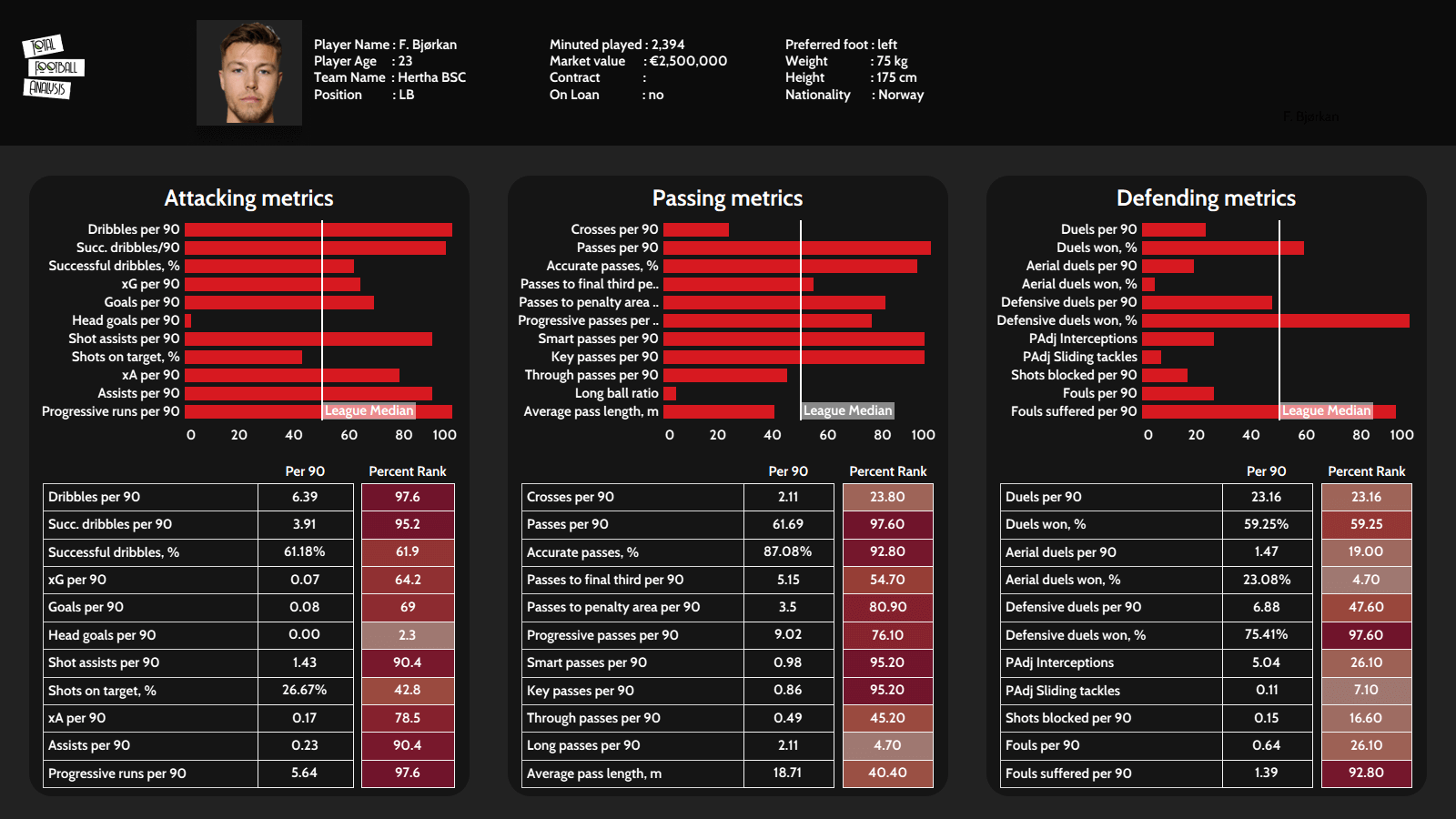
Bjørkan has been one of the standout performers in most of our metrics and rightfully gets a place in the shortlist. However, it remains to be seen how open would Barcelona be to taking a risk on a largely unproven commodity. The Norwegian currently plays for Hertha BSC and is a very versatile young talent. When it comes to his skill set, he fits the mould almost perfectly, albeit with some added caveats.
Firstly, the 23-year-old is very good in 1v1 duels, capable of beating his man and advancing up the flanks. Similarly, his on the ball ability is excellent as both his selection and weight of passes seem to be on a very high level, especially for such a young player. Bjørkan can thread cut-backs and deploy long balls over the top both in settled phases of possession and against the run of play.
However, it does seem he’s more adept at cutting through the left-half space than necessarily holding width. It’s not that he cannot do it but he does prefer moving infield when advancing with and without the ball. Without explosive pace in his arsenal, replicating the high-flying Alba role might not be his forte after all. But Bjørkan is still more than capable of staying wide, overlapping and then combining in the final third. Even if he sits deeper as more of a supportive, inverted option, his delivery and dribbling are still more than good enough to complement Barcelona’s forward line.
The best thing about the Norweigan, however, is still his versatility. Bjørkan can use both of his feet and can play equally well as a more attacking full-back on the left and as an inverted option on the right. This suits Barcelona’s needs perfectly because they get a player to cover both sides and theoretically adapt to both roles almost seamlessly.
Seeing how he’d potentially not be as expensive as some other options, Barcelona could be looking at a bargain player to cover multiple lacking areas.
3. The most realistic option: Álex Grimaldo
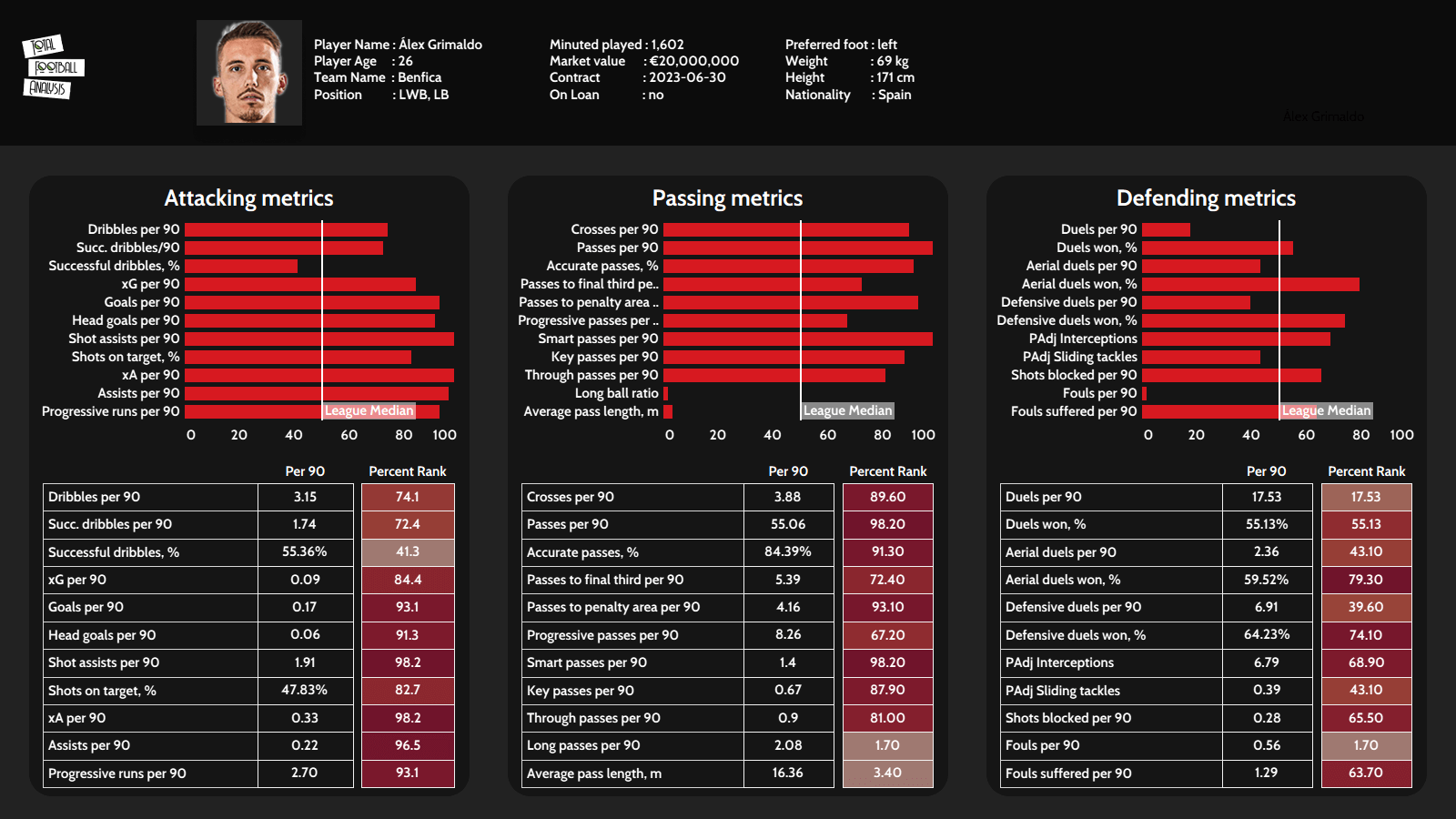
Grimaldo is someone who wouldn’t necessarily make the list on elite ability but seeing he is the most realistic option that’s also impressed in certain metrics, I wanted to include him on the shortlist. The ex-Barcelona left-back is a very good attacking option and could provide the team with a similar output to what they’re getting from Alba. However, he’s not a carbon copy.
The 26-year-old is in his prime years and is a very creative attacking profile, albeit playing in a more inverted role with the ability to overlap when necessary. As such, I don’t think he mirrors Alba in their movement and positioning but he does, to an extent, in his influence in the final third. It remains to be seen how his numbers translate from Portugal to LaLiga but there is no escaping the fact they are quite impressive.
Grimaldo tops the metrics in terms of both passing and attacking categories and clearly has an elite delivery as well as formidable 1v1 capabilities. The fact he is also a set-piece specialist who shoots and scores often is just a bonus that Xavi would gladly take. Defensively, he is decent but not necessarily better than Alba, who is a good and slightly underrated defender in his own right.
But considering Barcelona’s budget, Grimaldo’s ties with the club and his profile, this particular transfer is the most realistic one in the upcoming summer. He’s not the ideal Alba successor but could turn into a competent one for now.
Bonus option 1: Angeliño
Angeliño is one of the players who ticks the creative boxes and then some. While he may not be the marauding option that Alba or Pedraza are, the RB Leipzig left-back is an incredible crosser of the ball and a playmaker from deep. His elite delivery would gel extremely well with a forward line consisting of players who attack space and need to be fed passes consistently.
While his dribbling ability is still more than just decent, Angeliño isn’t a specialist in this regard. He will overlap when allowed to do so and will also do it competently well. However, his strengths are more visible when deploying lethal passes into the box from a slightly inverted and deeper position on the pitch. This, perhaps surpsingly, is what Xavi is instructing Alba to do more often in recent games as the full-back loses some of his speed and physical traits.
Angeliño would in that regard be a great option and a creative force behind the forward line that desperately needs such a profile. The fact he is listed as a bonus option doesn’t mean he’s valued less as he’d potentially edge out some other names mentioned earlier. Pedraza is the epitome of a high-flying left-back, Bjørkan is a potential unearthed gem while Grimaldo is by far the most realistic shout so I felt like including all of them.
However, Angeliño is someone whose skill set is compatible with the setup Xavi is trying to create.
Bonus option 2: José Gayà
Gayà is realistically the overwhelming favourite if he doesn’t renew. However, his performance would largely depend on what Barcelona expect him to do. If they want a direct Alba replacement, the Valencia man will not meet their expectations. Gayà is overall a much better footballer than Pedraza, Galán or even Grimaldo; he’s very good on the ball, combines extremely well with his teammates, has leadership qualities and is used to being much more involved. But he is also nowhere near an attacking threat.
When it comes to profiles, Gayà is more suited to what Barcelona are looking for on the right side than on the left. As a high-flying, marauding and overlapping full-back, he would struggle to replicate Alba’s output in the final third and the same is true for his delivery ability, which is good but not elite. He’s not as lethal in his final ball nor is he that explosive penetrative option moving forward. As an outlet, he wouldn’t bring the same results to the Catalans and would, because of that, likely be heavily criticised.
In reality, however, the reason for his struggle would simply be misuse. If Barcelona wanted a more combination-capable and supportive left-back, Gayà would still fit. But there is no escaping the fact his output would have to increase drastically to be good enough as the Valencia man struggled to top most of the categories we’ve dissected in our data analysis.
The right-back role
The main reason I’ve divided the roles into two separate sections is the huge difference in profile. While the left-back role demanded an attacking full-back with a great final third contribution, the right-back will be similar in some aspects but entirely different in others. If Alba’s output was the one to match in the first part of this data analysis, Dani Alves’ contribution will be that here. Note, however, that we are not looking for the next Alves or Alba, rather a player who can replicate their influence in Xavi’s newly-introduced system.
Our right-back needs to be a combinatory player with great technical qualities but also with the ability to invert, play passes from a more central position and be a creative force. The emphasis here is not necessarily on the overlap as it’s likely Xavi continues with a wide right-winger profile in the future too. However, since Barcelona would ideally have a winger who can go both inside and outside, that means the right-back playing behind him should also be able to do the same.
So the players we’ll list here will be technical inverted right-backs who could also potentially hold the width if and when necessary. The metrics used will reflect that as well.
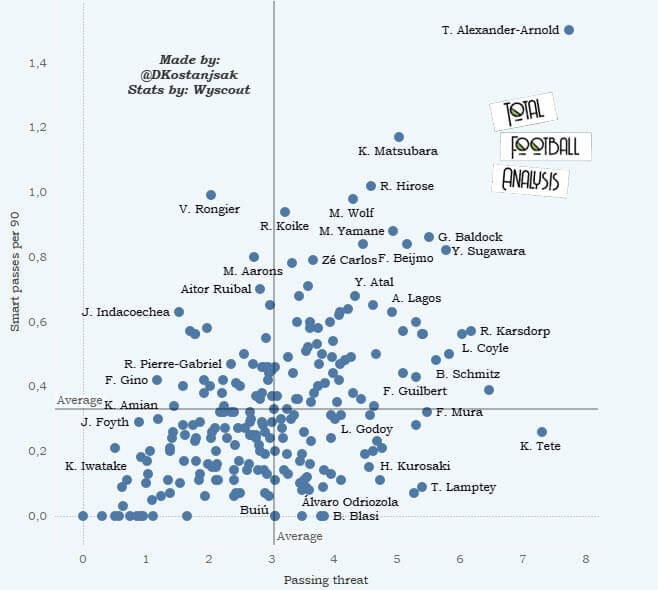
Since creation through passing is a major aspect of the profile we’re looking for, we’ll start the analysis by looking at smart passes per 90 and passing threat. This gives us players who are proficient at creating while also linking up with their teammates deep in the opposition’s block.
Trent Alexander-Arnold is someone whose inclusion isn’t a surprise here. While he’s still an impossible target for Barcelona, similarly to Davies, he could be a realistic one in the years to come. Arnold is young and has already won everything with Liverpool. If the Reds experience a slight drop in the next couple of seasons, this could prompt the young star to look for new challenges. The allure of Spain may very well be real.
George Baldock is also someone who excels in both categories. The 28-year-old Sheffield United right-back is incredible on the ball and can combine and create very well. The same can be said for several J1 League players but while their inclusion is impressive and could present an interesting scoop for Barcelona, at this point it’s highly unlikely the Catalans dip their toes into that specific market. Kenny Tete is another great example, albeit proficient in only one category.
But it’s the inclusion of Noussair Mazraoui that is a good sign, considering Barcelona have already expressed their interest in the Ajax talent. Interestingly, their own Sergiño Dest recorded decent numbers both in these metrics and the more aggressive ones we’ve used for the left-back search. His transformation into an inverted role could be a potential solution but an analysis for another time.
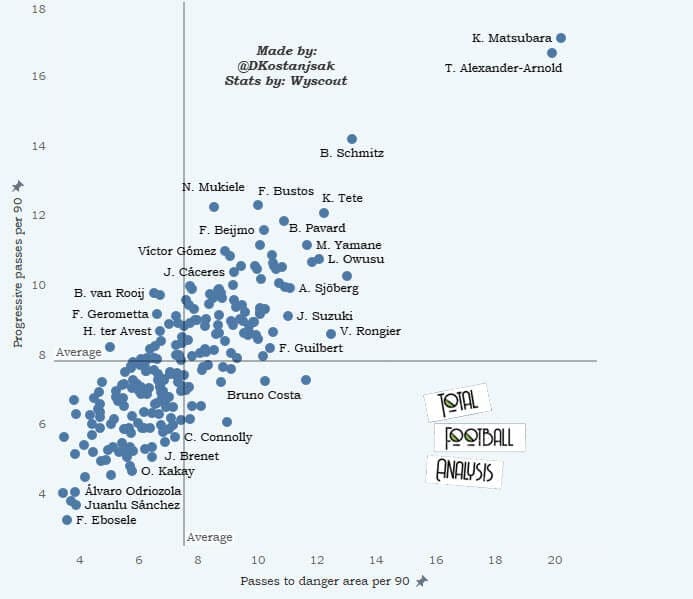
The next two graphs will delve deeper into our players’ passing repertoire, highlighting their progression ability. If they are to be inverted options, sometimes acting as false pivots or interiors for Barcelona, they need to be good progressors too. Again, Alexander-Arnold and J1 players dominate the metrics. However, Benno Schmitz is an interesting inclusion since his name also popped up in the previous graph. The same can be said for Tete and Lewie Coyle, both of whom are very impressive in their own right.
Since we’re not only looking for inverted options but rather for players that can also hold width if needs be, I’ve used some metrics like 1v1 prowess to see which of the names have a potential for overlaps. The colour depicts that. Note, however, that there is no single metric that can tell us this with 100% certainty so the eye test is always required. But if the players tend to accelerate with the ball and are great in 1v1 duels, it could theoretically suggest they have overlap potential.
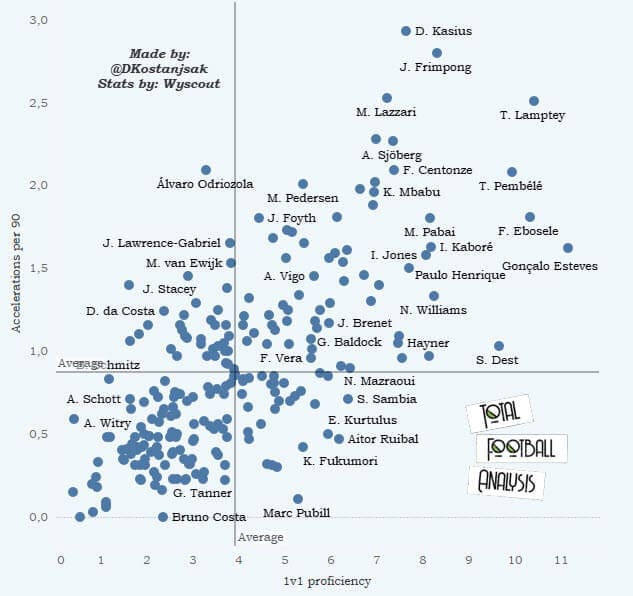
Tariq Lamptey, Denso Kasius, Jeremie Frimpong and Tino Livramento are the type of young full-backs who would fit this marauding right-back profile. They are exceptionally dangerous in isolated duels and can create threat from a wide area easily. Similarly, they can progress play via their runs and will conquer territory if given space out wide to do so. However, it all depends on the right-winger profile in front of them.
All of these players work best when given control of the flank and allowed to act more as wingbacks or even wingers at times, similarly to Alba. That’s why a two-way winger would be ideal for Barcelona. Looking deeper into their passing capabilities and threat they generate through it, we’ll now revisit the cut-back and crossing proficiency with right-backs as well.
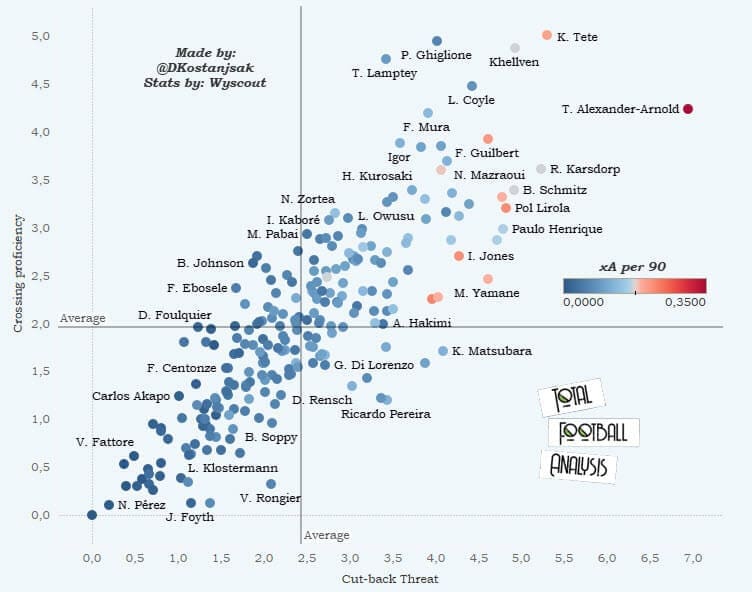
Alexander-Arnold is incredible once more but so are Lamptey, Tete, Athletico Paranaense’s Khellven and Coyle again. These players are elite in their delivery and some have the 1v1 prowess to complement it too. Mazraoui is also among the impressive names present here, which is an encouraging sign.
Without further ado, let’s now introduce our shortlist.
The right-back shortlist
1. Noussair Mazraoui
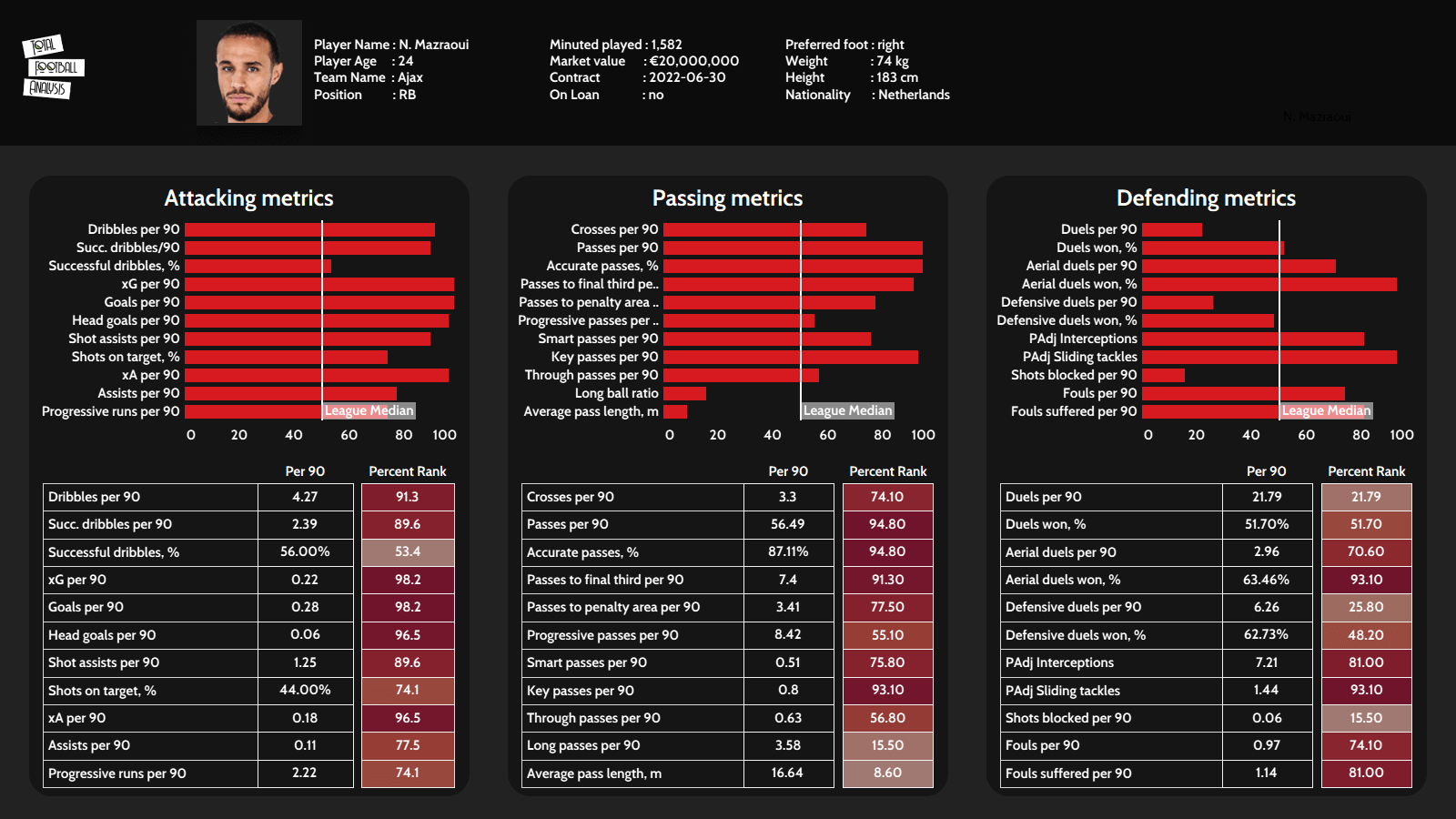
Mazraoui seems like the best option for Barcelona at the moment. Taking into account the profile Xavi currently wants for his right-back and the winger on the same side, the Ajax talent fits the mould. The 24-year-old is an excellent technical choice that has the on-the-ball ability to create from a deeper position.
His progressive numbers are also decent and paired up with high involvement and smart passing, it means he is able to link up well, is used to having the ball a lot and can unlock compact blocks in possession. But considering we are looking for well-rounded options, Mazraoui becomes an even better choice due to his excellent 1v1 and duelling ability.
Despite being more of an inverted, combinatory option, the 24-year-old is still dangerous in isolated situations and can provide width through overlaps when and if necessary. Interestingly, apart from being a creative spark that assists, Mazraoui has an eye for goal too, recording top expected goals figures as well.
Overall, he ticks most of the boxes for the type of right-back Xavi would want to have in his system and is both a fitting and impressive profile of a player. Most importantly, however, he also seems like a genuine target for Barcelona. This signing would make sense.
2. Benjamin Pavard
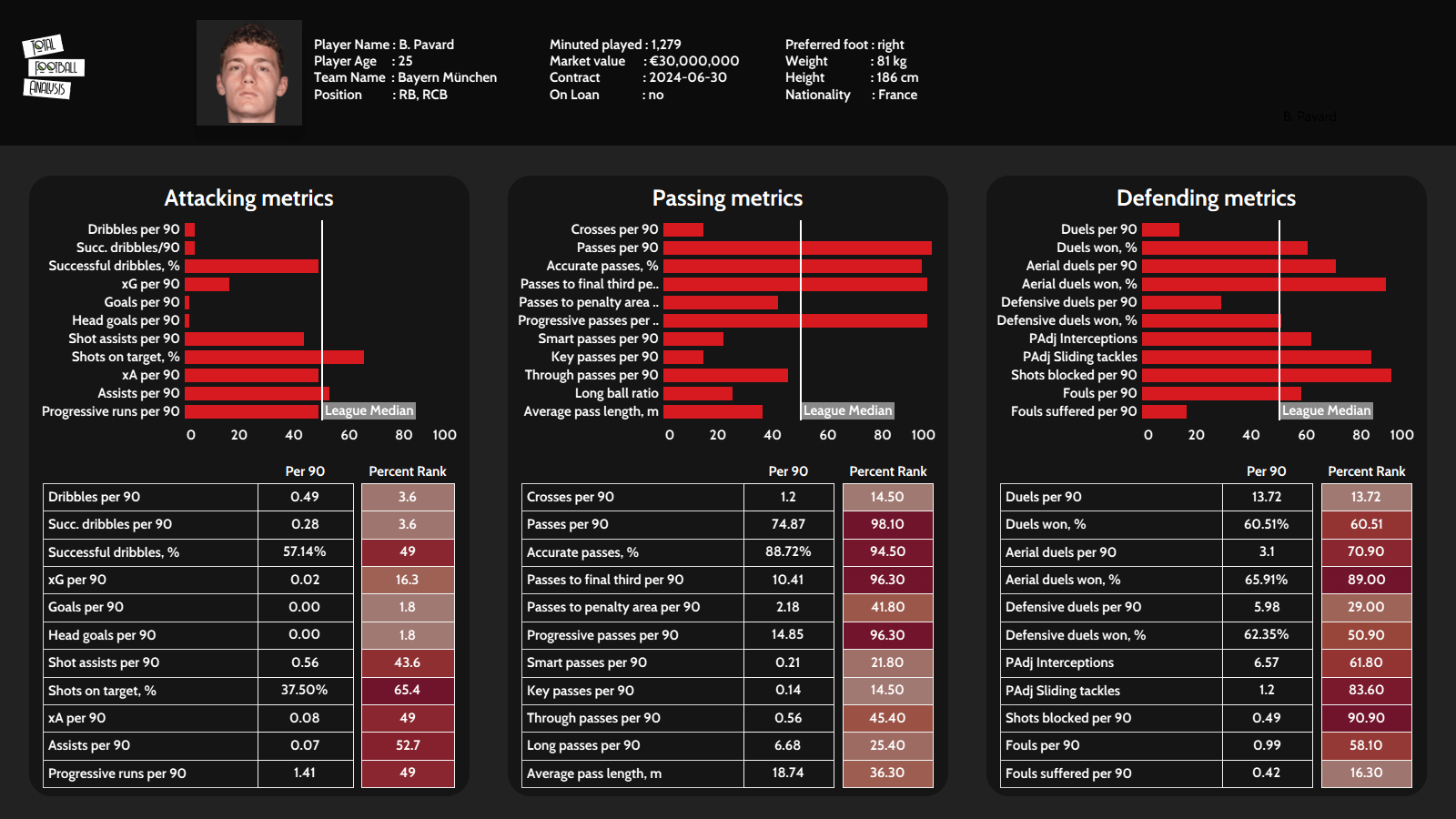
Benjamin Pavard is someone Barcelona have been linked with in the past and he indeed does have certain qualities Xavi would love to have in his current system. Considering the type of right-back that would do well with a wide winger, the 25-year-old fits the mould of a more supportive full-back that stabilises the team in possession, can progress play and is also defensively secure as cover behind the more creative and penetrative player(s) ahead of him.
Looking at his numbers, Pavard is great on the ball, albeit not as creative or lethal as someone like Mazraoui. However, acting as the deeper-positioned full-back who can invert, see a lot of the ball, recycle it and progress, he’d do quite well in a possession-heavy system akin to Bayern Munich’s.
If Barcelona deploy a creative right-winger ahead of him with limited tracking back or defensive ability, Pavard would serve well as good cover to patch up the team’s lacking transitional prowess and rest-defence. It’s a very underrated trait that comes at a cost of a more creative spark in that position. However, all-out attack isn’t necessarily the ideal solution and if paired up with a complementary winger profile, I feel Pavard would do quite well at Barcelona.
His contract expires in 2024 and he’s also in his prime. Buying from Bayern isn’t always easy so the price tag and availability should be taken into consideration. But in terms of profile and fitting ability, Pavard could be a decent option for the Catalans.
3. Benno Schmitz
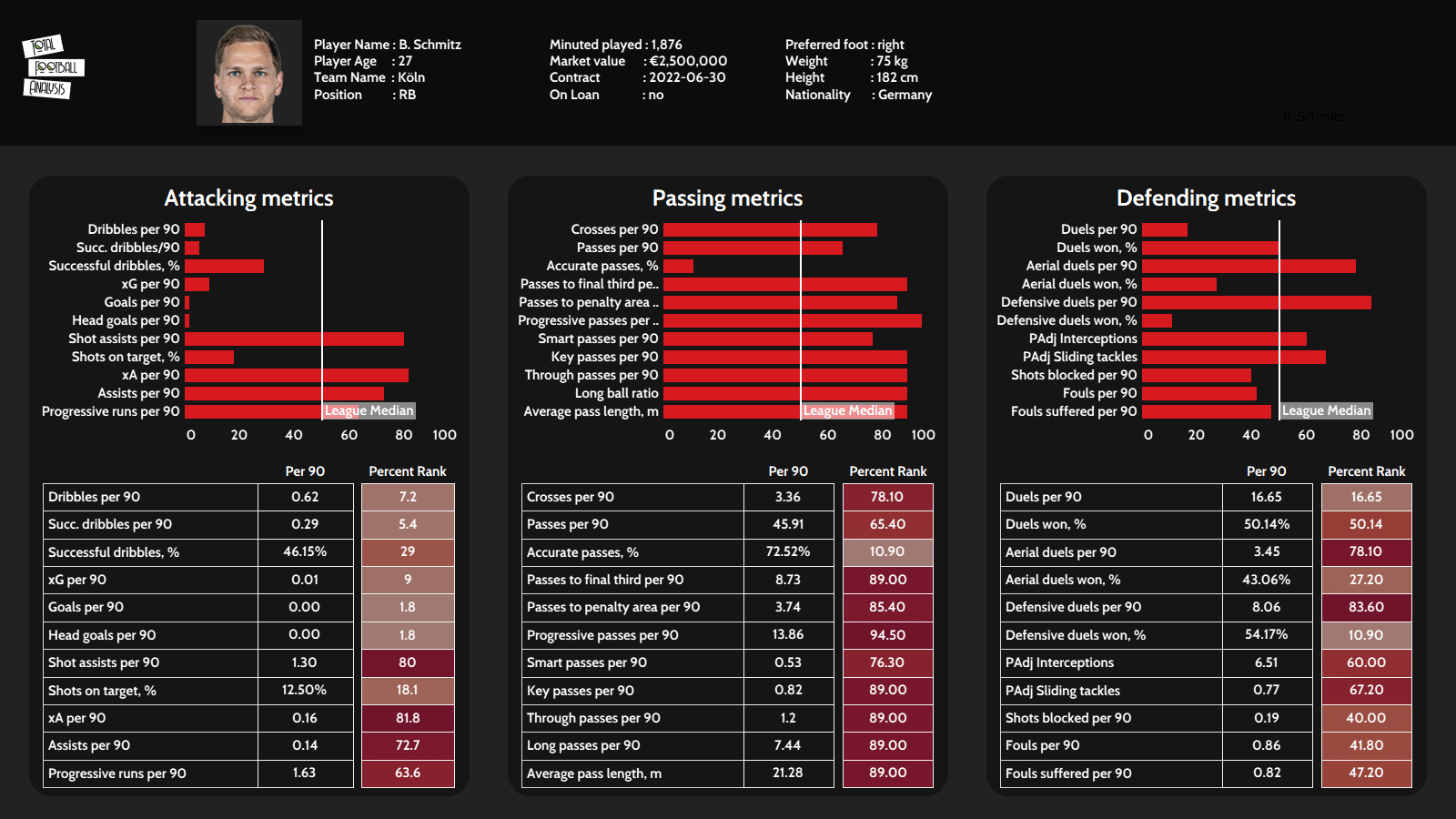
Schmitz is the least likely option on the list but I wanted to include a lesser-known and somewhat under the radar player to round off the analysis. The 27-year-old 1. FC Köln man is extremely similar to Pavard but with better statistical output. Schmitz fits the mould of a more supportive full-back that can create from the back, progress and link-up play as well as create.
He’s far more creative than his Bayern counterpart, in defence, he’s equally as solid but less of a direct threat to the opposition’s goal. However, the last part is not exactly what we’re looking for anyway. Schmitz’s on the ball ability, though, is outstanding. The 27-year-old tops almost every category compared to other Bundesliga defenders, including smart passes, key passes, passes per 90, progressive passes, through balls and long passes per 90. That is seriously impressive.
With his frame of 182 cm and 76 kg, Schmitz is also decently built and defensively astute. He reads the game well and is a good presence in the air and on the ground. However, as far as his 1v1 ability and goalscoring capabilities go, he won’t offer much. In that sense, deploying him as a pure overlap option or a wingback wouldn’t work as well as a more supportive, deep creator.
Overall, it’s unlikely Barcelona go for someone like him who’s not an established star at 27 years of age but we cannot deny he fits the profile and has been very impressive so far in 2021/22. On top of that, his contract is set to expire in the summer. It’s risky but with a potentially big upside.
Bonus options: The marauding right-back
As was the case with left-backs, I wanted to include some right-backs with a drastically different profile in case Barcelona wanted to go in a completely different direction. The likes of Lamptey, Isaiah Jones, Tino Livramento or even Tete to a certain extent are all players from England that can serve as far more aggressive attacking options on the right side of the pitch.
Admittedly, they are mostly deployed as wing-backs or even wingers that excel in 1v1 duels and have impressive physical attributes to beat their man and then pose incredible threat in the final third. They are, however, not as combinatory in their nature as the other options mentioned above. If Barcelona went in this direction, such players would inevitably have to be paired up with inverted forward, false wingers or wingers who drift centrally into a no.10 position.
At the moment, with Xavi’s clear preference for wide wingers, this doesn’t seem as realistic but players of such profile are out there if Barcelona do change their approach.
Final remarks
The full-back market is very tough and Barcelona won’t have a considerable budget to spend big money on that position. However, hopefully this data analysis has found some interesting names that could assist the Catalans in their search for new options to rejuvenate the wide areas.

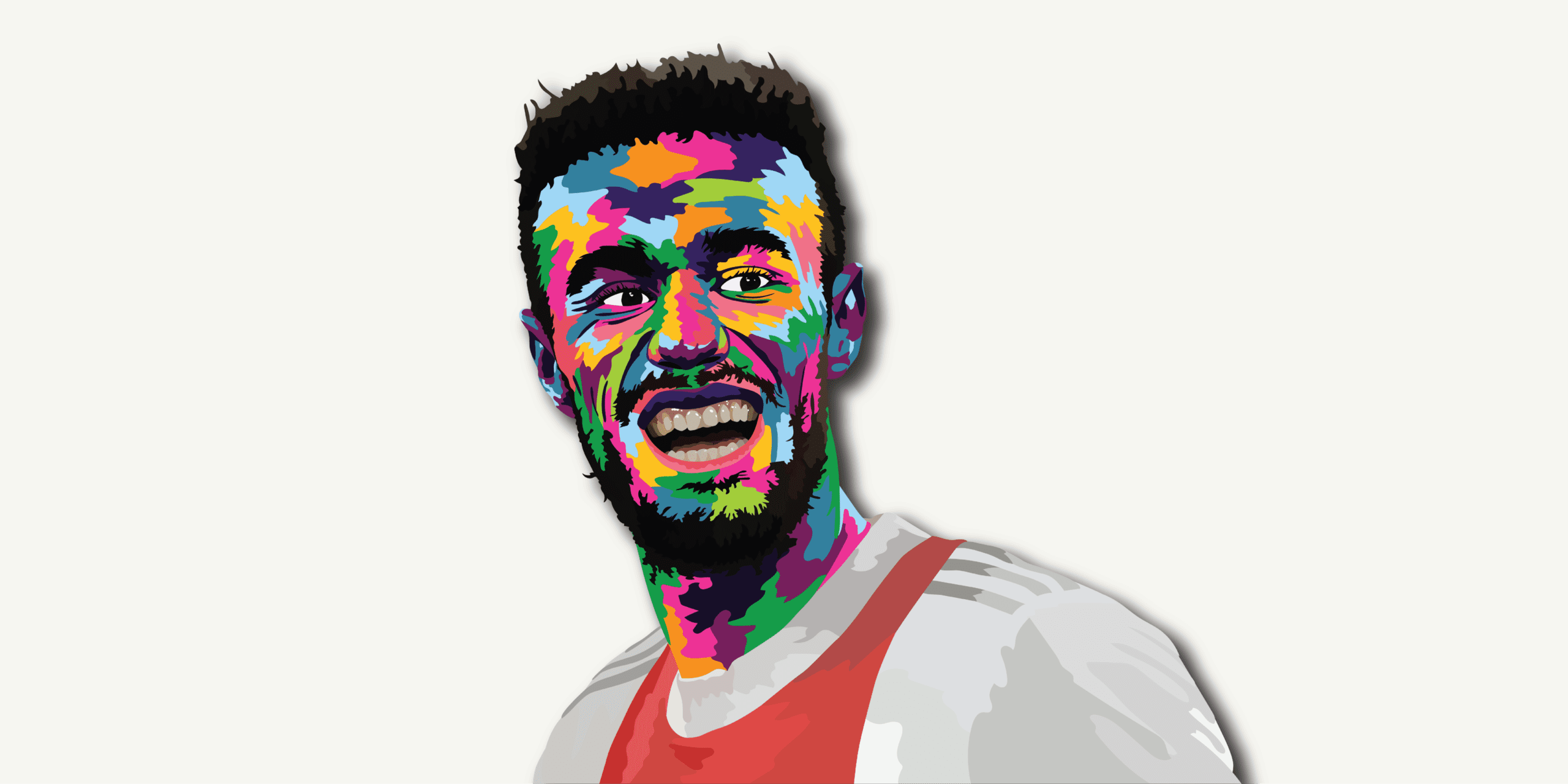




Comments